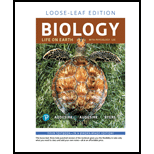
Concept explainers
Introduction:
The senses provide information to the brain about the nature and intensity of the environmental stimuli. Nature of the stimulus can be “light and sound” and intensity is defined by the strength of the stimulus, such as “loud or soft sound, dim or bright light”, and so on.
The special senses like taste, vision, hearing, smell, and touch carry stimuli from the sensory receptors and transmit these impulses towards brain for interpretation.
Answer to Problem 1MC
Correct answer:
Sensory receptors that respond to movement, gravity, or sound are mechanoreceptors. Therefore, option (b) is correct.
Option (b) is given as “mechanoreceptor”.
Explanation of Solution
Justify reason for the correct statement:
Mechanoreceptors are a specific sensory receptor. They track the changes in touch/ pressure/ tips (such as finger, hearing, lips, balance and body position). It generates receptor potentials when their membranes are depressed or stretched. Mechanoreceptors are present all over the body parts, skin (that senses to touch, pressure, or vibration), internal organs (such as the stomach, intestine, urinary bladder, and muscles), and inner ear (that senses sound, movement or gravity).
Hence, option (b) is correct.
Justify reasons for the incorrect statements:
Option (a) is given as “Chemoreceptors”.
Chemoreceptors are sense specific receptors present on the taste buds, the lining of the nasal cavity (olfactory receptors), and in internal receptors like blood
Option (c) is given “photoreceptors”.
Photoreceptors are sense specific receptors that sense visible light such as the eye. Hence, it is a wrong answer.
Option (d) is given as “thermoreceptors”.
Thermoreceptors sense temperature changes that occur in the skin. Hence, it is a wrong answer.
Hence, options (a), (c), and (d), are incorrect.
Mechanoreceptors are located in all over the human body and sense all physical deformation such as bending, dimpling, and stretching that occurs in various parts of the body.
Want to see more full solutions like this?
Chapter 40 Solutions
Pearson eText Biology: Life on Earth with Physiology -- Instant Access (Pearson+)
- What symbolic and cultural behaviors are evident in the archaeological record and associated with Neandertals and anatomically modern humans in Europe beginning around 35,000 yBP (during the Upper Paleolithic)?arrow_forwardDescribe three cranial and postcranial features of Neanderthals skeletons that are likely adaptation to the cold climates of Upper Pleistocene Europe and explain how they are adaptations to a cold climate.arrow_forwardBiology Questionarrow_forward
- ✓ Details Draw a protein that is embedded in a membrane (a transmembrane protein), label the lipid bilayer and the protein. Identify the areas of the lipid bilayer that are hydrophobic and hydrophilic. Draw a membrane with two transporters: a proton pump transporter that uses ATP to generate a proton gradient, and a second transporter that moves glucose by secondary active transport (cartoon-like is ok). It will be important to show protons moving in the correct direction, and that the transporter that is powered by secondary active transport is logically related to the proton pump.arrow_forwarddrawing chemical structure of ATP. please draw in and label whats asked. Thank you.arrow_forwardOutline the negative feedback loop that allows us to maintain a healthy water concentration in our blood. You may use diagram if you wisharrow_forward
- Give examples of fat soluble and non-fat soluble hormonesarrow_forwardJust click view full document and register so you can see the whole document. how do i access this. following from the previous question; https://www.bartleby.com/questions-and-answers/hi-hi-with-this-unit-assessment-psy4406-tp4-report-assessment-material-case-stydu-ms-alecia-moore.-o/5e09906a-5101-4297-a8f7-49449b0bb5a7. on Google this image comes up and i have signed/ payed for the service and unable to access the full document. are you able to copy and past to this response. please see the screenshot from google page. unfortunality its not allowing me attch the image can you please show me the mathmetic calculation/ workout for the reult sectionarrow_forwardIn tabular form, differentiate between reversible and irreversible cell injury.arrow_forward

 Human Biology (MindTap Course List)BiologyISBN:9781305112100Author:Cecie Starr, Beverly McMillanPublisher:Cengage Learning
Human Biology (MindTap Course List)BiologyISBN:9781305112100Author:Cecie Starr, Beverly McMillanPublisher:Cengage Learning Biology (MindTap Course List)BiologyISBN:9781337392938Author:Eldra Solomon, Charles Martin, Diana W. Martin, Linda R. BergPublisher:Cengage Learning
Biology (MindTap Course List)BiologyISBN:9781337392938Author:Eldra Solomon, Charles Martin, Diana W. Martin, Linda R. BergPublisher:Cengage Learning Comprehensive Medical Assisting: Administrative a...NursingISBN:9781305964792Author:Wilburta Q. Lindh, Carol D. Tamparo, Barbara M. Dahl, Julie Morris, Cindy CorreaPublisher:Cengage Learning
Comprehensive Medical Assisting: Administrative a...NursingISBN:9781305964792Author:Wilburta Q. Lindh, Carol D. Tamparo, Barbara M. Dahl, Julie Morris, Cindy CorreaPublisher:Cengage Learning Principles Of Radiographic Imaging: An Art And A ...Health & NutritionISBN:9781337711067Author:Richard R. Carlton, Arlene M. Adler, Vesna BalacPublisher:Cengage Learning
Principles Of Radiographic Imaging: An Art And A ...Health & NutritionISBN:9781337711067Author:Richard R. Carlton, Arlene M. Adler, Vesna BalacPublisher:Cengage Learning





